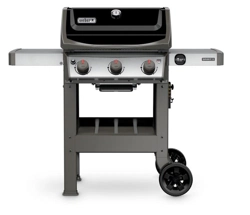Loading ...
Loading ...
Loading ...

9
Getting Started
Important Information about
LPG & GasConnections
What is LPG?
Liquefied petroleum gas, also called LPG, is the
flammable, petroleum-based product used to fuel your
barbecue. It is a gas at moderate temperatures and
pressure when it is not contained. But at moderate
pressure inside a container, such as a cylinder, LPG is
a liquid. As pressure is released from the cylinder, the
liquid readily vaporises and becomes gas.
Safe Handling Tips for Cylinders
• A dented or rusty cylinder may be hazardous and
should be checked by your supplier. Donot use a
cylinder with a damaged valve.
• Although your cylinder may appear to be empty,
gas may still be present, and the cylinder should be
transported and stored accordingly.
• The cylinder must be installed, transported, and stored
in an upright, secure position. Cylinders should not be
dropped or handled roughly.
• Never store or transport the cylinder where
temperatures can reach 51.7°C (125°F) (the cylinder
will become too hot to hold by hand). Use caution in
freezing conditions as well.
• Routinely check the cylinder to ensure the test date
has not expired. Do not use a cylinder which has an
expired test date.
Cylinder Requirements
• Use cylinders with a minimum capacity of 8.5 kg.
What is a Regulator?
Your gas barbecue is equipped with a pressure
regulator, which is a device to control and maintain
uniform gas pressure as gas is released from the
cylinder.
General Specifications
• Refer to data plate on barbecue for gas type,
consumption, pressures and injector sizing details.
• Gas inlet connection - 3/8" SAE Flare with 5/8" UNF
thread.
Regulator and Hose Requirements
• The pressure regulator supplied with the barbecue
must be used. This regulator is set for 2,75 kPa and
complies with the requirements of AS/NZS 5601.
• Avoid kinking the hose.
• Replacement regulator and hose assemblies must be
as specified by Weber-Stephen Products LLC.
m IMPORTANT: We recommend that you replace
the gas hose assembly on your gas barbecue
every five years. Some countries may have
requirements that the gas hose be replaced
within less than five years, in which case that
country’s requirement would take precedence.
For replacement hose, regulator, and valve
assemblies, contact the Customer Service
Representative in your area using the contact
information on our web site.
Log on to weber.com.
POL Connection
Hose
Regulator
Regulator Vent Hole (point hole downward)
POL coupling (tighten anti-clockwise)
LPG cylinder valve handwheel (close clockwise)
FOILPANS
Perfect for lining the
catchpan to make cleanup
convenient and easy.
M
U
S
T
-
H
A
V
E
T
O
O
L
S
•
M
U
S
T
-
H
A
V
E
T
O
O
L
S
•
M
U
S
T
-
H
A
V
E
T
O
O
L
S
•
M
U
S
T
-
H
A
V
E
T
O
O
L
S
•
M
U
S
T
-
H
A
V
E
T
O
O
L
S
•
M
U
S
T
-
H
A
V
E
T
O
O
L
S
•
M
U
S
T
-
H
A
V
E
T
O
O
L
S
•
BRUSH
AND MOP
Look for a basting brush with heat-
resistant silicone bristles and a long
handle. A mop with long, cotton
threads that sop up the thinner,
vinegar-based sauces.
M
U
S
T
-
H
A
V
E
T
O
O
L
S
•
M
U
S
T
-
H
A
V
E
T
O
O
L
S
•
M
U
S
T
-
H
A
V
E
T
O
O
L
S
•
M
U
S
T
-
H
A
V
E
T
O
O
L
S
•
M
U
S
T
-
H
A
V
E
T
O
O
L
S
•
M
U
S
T
-
H
A
V
E
T
O
O
L
S
•
M
U
S
T
-
H
A
V
E
T
O
O
L
S
•
SPIRIT II Burner Valve Orifice Sizes & Consumption Data
Gas Category BURNER VALVE ORIFICE SIZES
I
3B/P
(30 mbar or 2.8 kPa)
2 Burner Models 3 Burner Models Side Burner Models
Main Burners 1.02 mm Main Burners 0.89 mm Side Burner 0.94 mm
TOTAL CONSUMPTION DATA
210 Models 220 Models 310 Models 320 Models
28.2 Mj/h 40.2 Mj/h 30.9 Mj/h 42.9 Mj/h
Loading ...
Loading ...
Loading ...
